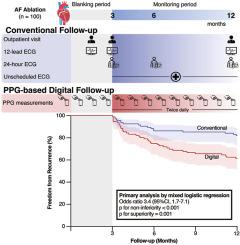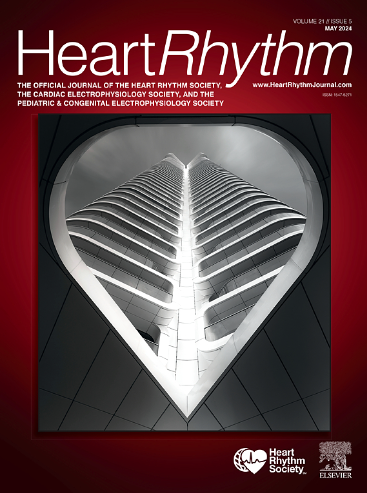Effectiveness of photoplethysmography-based rhythm monitoring after atrial fibrillation ablation using a smartphone application: DIGITOTAL study
IF 5.7
2区 医学
Q1 CARDIAC & CARDIOVASCULAR SYSTEMS
引用次数: 0
Abstract
Background
Recurrence after atrial fibrillation (AF) ablation is frequent. Monitoring with long-term electrocardiograms (ECGs) is constrained by limited monitoring time, measurement dispersion, and cost. Selected photoplethysmography (PPG) smartphone applications have demonstrated excellent accuracy for AF detection and could mitigate these limitations.
Objective
We aimed to compare the effectiveness of digital follow-up using a PPG-based smartphone application against conventional ECG-based follow-up for the detection of atrial arrhythmia recurrence after ablation.
Methods
Patients undergoing AF ablation were consecutively enrolled and monitored by a 24-hour ECG at 3, 6, and 12 months on top of the ECGs conducted for clinical indications (conventional follow-up). In addition, patients were instructed to perform PPG measurements twice daily or whenever symptoms were perceived during the course of 1 year (digital follow-up).
Results
In total, 96 patients (69% male; mean age, 64 ± 9 years) performed 39,895 PPG measurements. The compliance rate (number performed/prescribed) was 92.6% for ECGs and 78.2% for PPG recordings. After 1 year of follow-up, atrial arrhythmia recurrence was detected in 17.7% of patients by conventional follow-up and in 38.5% of patients by digital follow-up (odds ratio, 3.4; 95% confidence interval [CI], 1.7–7.1). The CI lower limit exceeded the predefined noninferiority margin (P for noninferiority > .001). Hence, superiority was tested (P for superiority = .001). The negative predictive value of digital follow-up for atrial arrhythmia detected with conventional follow-up was 98.3% (95% CI, 90.9%–99.9%).
Conclusion
Digital rhythm follow-up using a smartphone application with PPG was noninferior to conventional follow-up in detecting atrial arrhythmia recurrence between 3 and 12 months after ablation. Moreover, digital follow-up significantly increased the detection of atrial arrhythmia.

心房颤动消融术后使用智能手机应用程序进行基于血压计的节律监测的有效性:DIGITOTAL-研究。
背景:心房颤动(房颤)消融术后经常复发。使用(长期)心电图(ECG)进行监测受到监测时间有限、测量分散和成本等因素的限制。部分光电血压计(PPG)智能手机应用已证明对房颤检测具有极高的准确性,可以缓解这些局限性:比较使用基于 PPG 的智能手机应用程序进行数字随访与基于传统心电图的随访在检测消融术后房性心律失常复发方面的有效性:方法:对接受房颤消融术的患者进行连续登记,并在3-6-12个月内使用24小时心电图对其进行监测,同时根据临床指征进行心电图检查(常规随访)。此外,还指导患者在一年内每天两次或在出现症状时进行 PPG 测量(数字随访):共有 96 名患者(69% 为男性,平均年龄为 64±9 岁)进行了 39895 次 PPG 测量。心电图和 PPG 记录的符合率(执行/处方人数)分别为 92.6%和 78.2%。随访一年后,17.7% 的患者通过常规随访发现房性心律失常复发,38.5% 的患者通过数字随访发现房性心律失常复发(OR 3.4;95%CI:1.7-7.1)。CI下限超过了预先确定的非劣效性范围(非劣效性 p >0.001)。因此,进行了优越性测试(优越性 p =0.001)。数字随访对传统随访发现的房性心律失常的阴性预测值为 98.3%(95%CI:90.9-99.9%):结论:在消融术后 3 至 12 个月期间,使用智能手机应用程序和 PPG 进行数字心律随访在检测房性心律失常复发方面并不优于传统随访。此外,数字化随访还能明显提高房性心律失常的检出率。
本文章由计算机程序翻译,如有差异,请以英文原文为准。
求助全文
约1分钟内获得全文
求助全文
来源期刊

Heart rhythm
医学-心血管系统
CiteScore
10.50
自引率
5.50%
发文量
1465
审稿时长
24 days
期刊介绍:
HeartRhythm, the official Journal of the Heart Rhythm Society and the Cardiac Electrophysiology Society, is a unique journal for fundamental discovery and clinical applicability.
HeartRhythm integrates the entire cardiac electrophysiology (EP) community from basic and clinical academic researchers, private practitioners, engineers, allied professionals, industry, and trainees, all of whom are vital and interdependent members of our EP community.
The Heart Rhythm Society is the international leader in science, education, and advocacy for cardiac arrhythmia professionals and patients, and the primary information resource on heart rhythm disorders. Its mission is to improve the care of patients by promoting research, education, and optimal health care policies and standards.
 求助内容:
求助内容: 应助结果提醒方式:
应助结果提醒方式:


